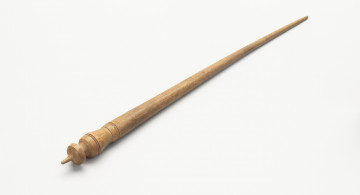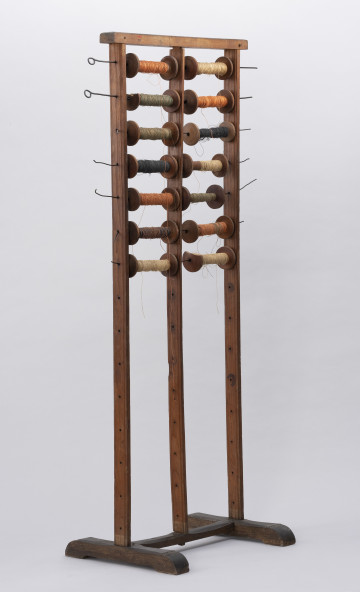
Spindle
1945 — 1970
National Museum in Szczecin
Part of the collection: Folk craft of the Lublin Region (19th/20th c.)
The towel, called a wrap, was used in the holiday costume of Włodawa. It was woven at the end of the 19th century near Biała Podlaska. It is 121 cm long and 32 cm wide. It was made of cotton self-made white linen woven by hand in a weaving workshop with plain weave, and its edges at the length of 14.5 cm are decorated with ornaments called ‘pereboras’ in red with an addition of yellow and navy blue. This form of decorative weaving ornament was adopted in Poland only near Włodawa, the southern part of Biała Podlaska and the eastern part of Parczew. Polish women learned how to make ‘pereboras’ from the Rusyns, who used them to decorate elements of women's (shirts, skirts, aprons) and men's (shirts) costumes. The pattern composed by the weaver forms a simple striped pattern, into which strips of a more or less elaborate geometric pattern are symmetrically inserted.
The towel described was used as a headdress for married women (similar towels were used to decorate the altar at home). Before it was put on, the towel was folded lengthwise into three parts, wrapped around the head and tied at the back in the so-called bow tie, so that the ends fell on the shoulders. The upper edge of the towel was fastened on the forehead to the hem of the kimbalka, which had been placed on the top of the head and fastened to the hair, thus forming two cones on the wrap. Sometimes women wore a second towel, which was first placed under the chin and its ends tied on the top of the head. This headdress is very archaic and characteristic of the eastern Slavs. It survived the longest in the Włodawa costume, but even there, at the beginning of the 20th century, women replaced it with a Tibetan kerchief tied under the chin.
Author / creator
Dimensions
cały obiekt: height: 120 cm, width: 32,5 cm
Object type
towel
Technique
weaving: canvas
Material
flax
Creation time / dating
Creation / finding place
Owner
The National Museum in Lublin
Identification number
Location / status

1945 — 1970
National Museum in Szczecin

1880 — 1920
National Museum in Szczecin

1801 — 1939
National Museum in Szczecin
DISCOVER this TOPIC
Museum of King Jan III's Palace at Wilanów
DISCOVER this PATH
Educational path